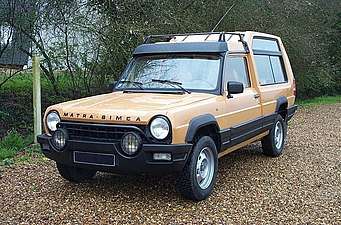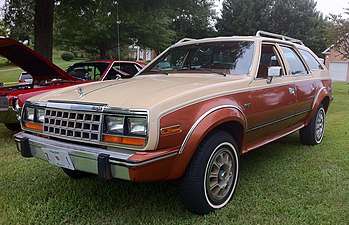Crossover (automobile)
A crossover—also called a CUV (crossover utility vehicle)—is a type of vehicle with unibody construction.[1] Crossovers are often based on a platform shared with a passenger car; compared to truck-based SUVs, they typically have better interior comfort, a more comfortable ride, and superior fuel economy, but lower off-road capability.[2][3][4] Poor off-road capability is compounded by many crossovers being sold without all-wheel drive, which challenges their definition as "sports utility vehicles".

Furthermore, there are various inconsistencies about whether some vehicles are considered crossovers or SUVs; therefore, the term "SUV" is often used as a catch-all for both crossovers and compact SUVs.[5]
In the United States as of 2006, crossover models comprised more than 50% of the overall SUV market.[6] Crossovers have also become increasingly popular in Europe since the early 2010s.
Forerunners of the modern crossover include the 1977 Matra Rancho and AMC Eagle introduced in 1979.[7]
Definition
The difference between crossovers and other SUVs is sometimes defined as a crossover being built using a unibody platform (the type used by most passenger cars), while an SUV is built using a body-on-frame platform (the type used by off-road vehicles and light trucks).[8][9][2][10] However, these definitions are often blurred in practice, since unibody vehicles are also often referred to as SUVs.[11][12] Also, "crossover" is a relatively recent term, and early unibody SUVs (such as the 1984 Jeep Cherokee) are rarely called crossovers. Due to these inconsistencies, the term SUV is often used as an umbrella term for both crossovers and SUVs.[13][3][14]
Outside of the United States, the term "crossover" tends to be used for C-segment (compact) or smaller vehicles, with large unibody vehicles—such as the Audi Q7, BMW X7 and Volkswagen Touareg—usually known as SUVs rather than crossovers. In the United Kingdom, a crossover is sometimes defined as a hatchback with raised ride height and SUV-like styling features.[15][16]
History
Introduced in 1979, the AMC Eagle is retroactively considered to be the first dedicated crossover automobile that made its debut prior to the terms "SUV" or "crossover" being coined.[17][18][19][20] The mass-market Eagle model line was based on a unibody passenger car platform, with fully automatic four-wheel drive and a raised ride height.[21][22][23][24][25]
Some cite the front-wheel drive 1977 Matra Rancho as a slightly earlier forerunner to the modern crossover.[26]
Though it is not part of the modern linear evolution, and only fifteen were built, some stretch the definition and history of the "crossover" to regard the off-road racing 1936 Opel Geländesportwagen as the first of the class.[27]
The 1994 Toyota RAV4 is credited as the model that expanded the concept and the crossover market segment.[28] Essentially a shrunken SUV, the RAV4 was based on the platform used by the Toyota Corolla.[4]
 1977 Matra-Simca Rancho
1977 Matra-Simca Rancho 1979-1987 AMC Eagle
1979-1987 AMC Eagle_Cruiser_wagon_(2015-07-14)_01.jpg) 1995 Toyota RAV4
1995 Toyota RAV4
Size categories
Subcompact crossover
Subcompact crossovers are usually based on the platform of a subcompact (also known as supermini or B-segment) passenger car.[29][30][31] They typically have limited off-road capabilities, with some differing from the standard hatchback model with only a bumper hinge and more ground clearance.
Compact crossover
Compact crossovers are usually based on the platform of a compact (also known as C-segment) passenger car. The first compact crossovers included the 1994 Toyota RAV4,[28] 1995 Honda CR-V, 2000 Nissan X-Trail, 2000 Mazda Tribute and 2001 Ford Escape.
The number of compact crossover models offered has rapidly increased since 2010. In 2019, it was stated by Car and Driver that "so many of these vehicles are crowding the marketplace, simply sorting through them can be a daunting task".[32]
Sales
Europe
Since the early 2010s, sales of crossover-type vehicles have been increasing in Europe.[33] By 2017, European sales of compact and mid-sized crossover models continued to surge.[34]
United States
Sales of crossovers increased 30% between 2003 and 2005.[3] By 2006, the segment came into strong visibility in the U.S., when crossover sales "made up more than 50% of the overall SUV market".[6] Sales increased in 2007 by 16%.[35] In 2013, the Audi Q5 became Audi's second best-selling vehicle in the United States market after the Audi A4 sedan.[36] Around half of Lexus' sales volume has come from its SUVs since the late 1990s.[37]
American manufacturers were initially slow to switch from their emphasis on light truck-based SUVs, and foreign automakers developed crossovers targeting the U.S. market as an alternative to station wagons that were unpopular there. But by the 2010 model year, American car manufacturers had caught up.[3]
See also
- Car classification
- Compact SUV
- List of SUVs
- Mini SUV
- Minivan
- Recreational vehicle
References
- "AutoMotion Blog Top 10 Crossover SUVs In The 2013 Vehicle Dependability Study". JD Power. 21 March 2013. Archived from the original on 19 August 2013.
- "Smart Buying Essentials What is a Crossover Vehicle?". Intellichoice. Archived from the original on 17 July 2011. Retrieved 27 July 2015.
- Isidore, Chris (9 January 2006). "GM and Ford's New Cross to Bear". CNN Money. Retrieved 27 July 2015.
- "Crossover 101". www.aol.com. Archived from the original on 16 April 2016. Retrieved 11 November 2019.
- "5 Reasons to Buy a Crossover Vehicle". HowStuffWorks. 22 October 2018. Retrieved 15 September 2019.
“Crossover” is now used almost interchangeably with “compact SUV,” but some new vehicles are pushing those boundaries.
- Carty, Sharon Silke (3 May 2006). "Crossover vehicles pass up SUVs on road to growing sales". USA Today. Retrieved 27 July 2015.
- Gold, Aaron (May 2017). "AMC Eagle: No, Seriously, This Was the First Crossover SUV". www.autotrader.com. Retrieved 15 September 2019.
- "Difference between a crossover vehicle and SUV?". www.hertzcarsales.co.uk. 30 January 2019. Retrieved 22 April 2019.
- "What is the Difference Between Crossovers and SUVs? « Harbin Automotive". www.harbinautomotive.com. Retrieved 22 April 2019.
- "What's the Difference Between an SUV, a Crossover, & a CUV?". www.thenewswheel.com. 30 March 2017. Retrieved 22 April 2019.
- "SUV vs. Crossover: What's the Difference?". www.autotrader.com. Retrieved 22 April 2019.
- "SUVs vs. Crossovers: What's the Difference?". www.usnews.com. Retrieved 22 April 2019.
- "The Difference Between SUVs and Crossover Cars". www.carwriteups.co.uk. 9 April 2018. Retrieved 22 April 2019.
- Fund, Daniel (February 2013). "2013 BMW X3 xDrive28i vs. 2013 Audi Q5 2.0T, 2013 Land Rover Range Rover Evoque". Car and Driver. Retrieved 27 July 2015.
- "What's the difference between a crossover, SUV and 4x4?". www.carbuyer.co.uk. Retrieved 22 April 2019.
- "SUV vs Crossover: What are the Differences and Similarities?". www.leasefetcher.co.uk. Retrieved 22 April 2019.
- "Who coined the term 'crossover vehicle?'". www.howstuffworks.com. 13 July 2011. Retrieved 8 December 2018.
- Gold, Aaron (May 2017). "AMC Eagle: No, Seriously, This Was the First Crossover SUV". Auto Trader. Retrieved 5 July 2017.
- Sherman, Don (1 February 2001). "All-Wheel-Drive Revisited: AMC's 1980 Eagle pioneered the cross-over SUV". Automotive Industries. Archived from the original on 1 May 2013. Retrieved 19 May 2017.
- "Roy Lunn - Inducted 2016". Automobile Hall of Fame. Retrieved 5 July 2017.
- Jacobs, Ed (September 1979). "Passenger-car comfort, plus 4wd security for all-weather security". Popular Science. 215 (3): 90–91. Retrieved 19 May 2017.
- Houlahan, Mark (3 August 2016). "Roy Lunn Inducted Into Automotive Hall Of Fame". Mustang Monthly. Retrieved 5 July 2017.
- Norbye, Jan P. (October 1980). "Half-Hour History of Four-Wheel-Drive Autos". www.hemmings.com. Special Interest Autos. Retrieved 6 December 2018.
- Carney, Dan. "AMC Eagle, the unlikely trail-blazer". BBC. Retrieved 6 December 2018.
1980 AMC Eagle, the first full-time all-wheel-drive passenger car to reach mass production.
- Flory, Jr., J. Kelly (2012). American Cars, 1973-1980: Every Model, Year by Year. McFarland. p. 775. ISBN 9780786443529. Retrieved 6 December 2018.
- "Matra Rancho: the original crossover". The Telegraph. 6 March 2015. Retrieved 19 May 2017.
- Carlsson, Mårten (26 June 2018). "Opel Geländesportwagen, en Cross-over från 1936" [Opel Geländesportwagen, a Crossover from 1936]. Klassiker (in Swedish). Sweden. Retrieved 7 July 2019.
- Madrigal, Alexis C. (10 July 2014). "Why Crossovers conquered the American Highway". The Atlantic. US. Retrieved 6 July 2017.
- "Prepare for the mini-SUV invasion…". Top Gear. 24 April 2012. Retrieved 29 August 2012.
- "Nissan Juke 1.5dCi Tekna Review". Autocar. Retrieved 24 May 2017.
- "Auto Express - First Drive Nissan Juke". jukeownersclub. Retrieved 24 May 2017.
- "Practicality Matters: Every Compact Crossover SUV Ranked from Worst to Best". Car and Driver. Retrieved 2 April 2018.
- Schmitt, Bertel (3 March 2017). "European Class Struggle: SUV-Crossovers De-class Golf-Class, Emissions Edge Up". Forbes. Retrieved 11 December 2018.
- Demandt, Bart (16 February 2018). "European sales 2017 compact & midsized crossover segments". carsalesbase.com. Retrieved 11 December 2018.
- White, Joseph B. (14 January 2008). "Crossover Market Is Thinly Sliced". The Wall Street Journal Blogs. Retrieved 27 July 2015.
- Pund, Daniel (February 2013). "2013 BMW X3 xDrive28i vs. 2013 Audi Q5 2.0T, 2013 Land Rover Range Rover Evoque". Car and Driver. Retrieved 27 July 2015.
- Taylor III, Alex (19 December 2011). "The most disliked cars of 2011". CNN. Archived from the original on 26 April 2012. Retrieved 27 July 2015.